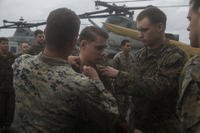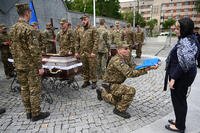The ever expedient Marine Corps plans to send field modified A/KC-130J transport-tanker-gunships to Afghanistan by the end of the year, to provide Marines fighting a resurgent Taliban there with much needed over-watch and precision close air support, Commandant Gen. James Conway said last week.
Marine commander’s have “lusted for years” over the AC-130 gunships, but the highly specialized aircraft are too costly for the cash strapped service, he said. Instead, the Marines have come up with the “Harvest Hawk” program, using a “roll-on, roll-off” sensor, targeting and weapons package that can be installed on a KC-130J aerial refueling tanker in a matter of hours. The KC-130J tanker has the needed long overhead loiter capability and can fly above Taliban air defenses, which Conway said they have been "beefing up." With the ISR package in the cargo bay, a 30mm cannon sticking out the side, and with Hellfire missiles hung on the aircraft’s wings, the program will transform the tankers into an “aircraft overheard with ISR and with sting,” he said, speaking at CSIS May 15 in Washington.
On a conference call with reporters earlier this month, Marine Corps aviation chief Lt. Gen. George Trautman, said the “soul” of the Harvest Hawk program is the palletized ISR package, already operational on other C-130s, “tied to a targeting system mounted on a wing station, and then tied into a weapons control station inside the airplane.” When Marines deployed to Afghanistan about a year and half ago they found one of the things they needed most was “persistent ISR on station for long periods of time.” The ability to fire guns and missiles would be an added bonus. In addition to the Hellfire, the aircraft might also carry Viper Strike missiles dropped from the rear ramp. He said Marine testers are still trying to determine whether they can get the needed accuracy with the 30mm cannon firing out the side of the aircraft and that they may hold off on that one for the time being.
Conway also addressed the issue of naval gunfire support, saying it was clearly a “deficiency” in search of a solution. While missiles fired from Navy ships can take out precision targets, the fleet's lack of long-range naval artillery means “volume of fires” is missing. The ability to saturate targets with high explosive is often vital in the early phases of an amphibious landing and the Navy doesn’t have the guns it used to, particularly now that the DDG-1000 program is being truncated.
So, in another expedient move, the Navy and Marines plan to "expand on the concept” of the LCS as a “firing platform” using a “box of rockets.” While the Marines don’t yet have rockets with the desired range and payload, “we’ve examined the [LCS] storage and elevator capacity to get them up to the flight deck… that’s how we think we fix the problem for the long term,” Conway said.
Conway said the Marines will likely emerge in pretty good shape from the ongoing QDR strategic review because of their unique adaptability, the fact the force is able to fight across a wide range of potential conflicts and that it gets a relatively small share of the overall defense budget.








